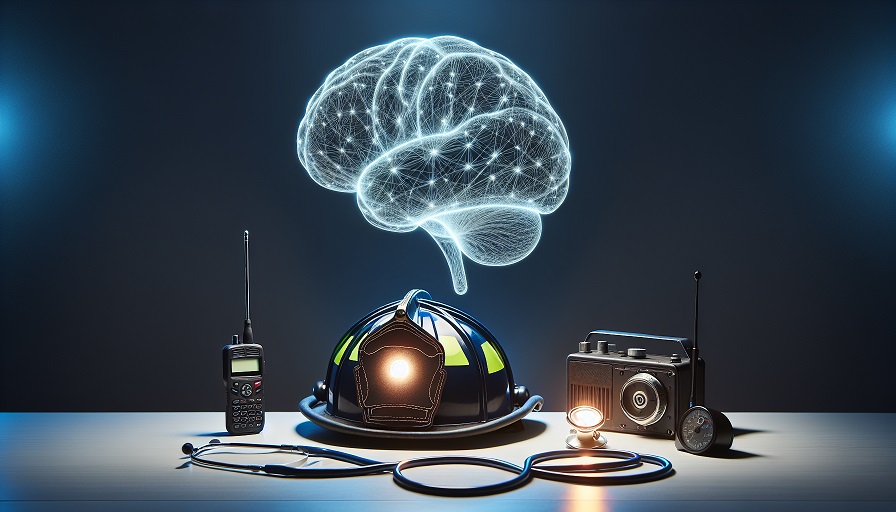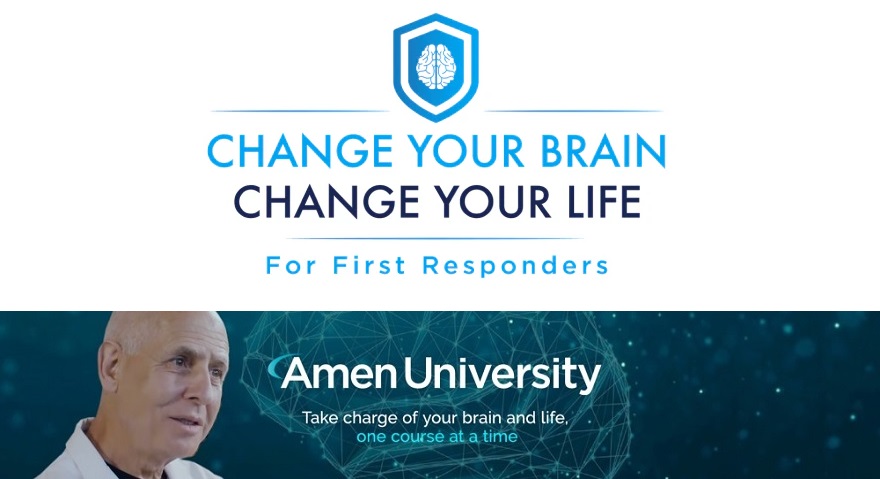
Police, firefighters, paramedics, dispatchers, corrections officers, and other first responders walk into situations that everyone else runs away from. Over time, that constant exposure to danger, trauma, and high stakes decisions can wear down the brain in quiet but serious ways. Sleep changes, irritability, numbness, overreactions, or feeling disconnected often show up long before anyone thinks about brain health.
Dr Daniel Amen’s course, often titled First Responders: Change Your Brain, Change Your Life, was created for this exact world. It pulls together neuroscience, mental health, and practical coping strategies in a format that speaks to responders and the people who lead them. Instead of asking first responders to become therapists, it teaches specific brain based skills they can use on and off duty.
Contents
Why A Brain Focused Program For First Responders
Traditional wellness trainings often focus on fitness, tactics, and policy. Those matter, but they rarely address the organ that filters every call, every memory, and every decision, the brain. The program starts from a simple idea. If you help responders understand their brains and how repeated stress changes them, you give them more control over their reactions and their long term health.
The Hidden Cost Of Constant Alert
First responder work keeps the alarm systems of the brain on a short trigger. Shift work, trauma exposure, and public scrutiny combine into a steady load on circuits that are meant for brief emergencies, not daily life. Over time that can show up as hypervigilance, emotional numbing, jumpiness, headaches, or problems with focus and memory.
The course is honest about this cost. It does not tell responders to simply toughen up. Instead, it explains how chronic stress physically alters blood flow, activity patterns, and chemistry in the brain, and why taking care of that organ is as tactical as taking care of equipment.
From Stigma To Brain Health Language
Many first responders hesitate to talk about how they are doing emotionally because they fear judgment or career consequences. One of Dr Amen’s goals is to shift the conversation away from weakness and toward brain health. Saying my brain has taken some hits is often easier than saying I think I am mentally falling apart.
That language change opens a door. It becomes more acceptable to ask how do I protect and heal my brain than to admit I cannot cope, even when the reality is the same.
How The First Responders Program Is Structured
The course is delivered through video lessons and supporting materials that responders can complete at their own pace or within agency led trainings. The segments are designed to fit into busy schedules and to be rewatched as needed.
Short Modules With Real Examples
Content is broken into focused modules that cover topics such as brain basics, the impact of trauma and stress, sleep and shift work, substance use, and concrete brain healthy strategies. Instead of long theory heavy lectures, lessons use stories and cases drawn from first responder life, which makes the material easier to relate to and remember.
That structure allows agencies to integrate the course into roll call training, wellness days, academy classes, or online learning without needing a large block of uninterrupted time.
Brain Imaging As A Teaching Tool
Because Amen Clinics uses SPECT brain imaging in clinical work, the First Responders program includes images of real brains affected by repeated trauma, substance use, and healing interventions. Responders see what overactive and underactive patterns look like and how those patterns can relate to symptoms such as impulsivity, anger, or emotional shutdown.
This visual element is not there to scare people. It is meant to make the invisible visible. When responders can see that their experiences may have changed how their brain functions, it validates what they feel and highlights the value of taking steps to improve brain health.
The Brain Health Skills The Program Teaches
Information alone does not change much. The heart of the course is a set of skills that responders can practice regularly. These skills are framed as tools for performance, safety, and family life, not just for crisis moments.
Understanding And Managing Automatic Thoughts
First responders are trained to scan for threats. That habit can creep into everyday thinking, leading to constant worst case scenarios, quick judgments, or assumptions that nothing will ever improve. The program introduces the idea of automatic negative thoughts and teaches responders how to catch, question, and reframe them.
Instead of treating every thought as fact, responders learn to ask is this completely accurate, what evidence supports it, and what else might be true. Over time this reduces unnecessary anger, hopelessness, and conflict, both at work and at home.
Practical Strategies For Healing From Trauma
The course explains what happens in the brain after critical incidents and ongoing exposure to distressing scenes. It normalizes common reactions, such as intrusive images, numbness, or feeling on edge, and it outlines when those reactions are likely to fade and when they may require professional help.
Responders are introduced to healthy coping options, such as trauma informed therapy, peer support, structured debriefing, and specific grounding techniques to use when memories or sensations surge. The message is that seeking help is a skilled response, not a failure.
Sleep And Shift Work Tactics
Sleep is a frequent casualty in first responder life. Rotating shifts, late calls, overtime, and family demands make consistent rest feel impossible. The program takes this seriously. It explains how sleep loss affects reaction time, mood, judgment, and long term brain health, then offers realistic tactics for imperfect schedules.
These tactics can include pre sleep routines, light management, brief recovery naps when appropriate, and strategies for transitioning off night shifts. The goal is not perfect sleep. It is better sleep within the limits of the job.
Substance Use And Brain Safety
Some responders lean on alcohol, stimulants, or other substances to unwind or stay alert. The training is frank about how these choices impact the brain over time. It shows how repeated use can worsen anxiety, depression, and impulse control, and how that can affect decision making in the field and at home.
The course encourages healthier ways to decompress and offers guidance on recognizing when use has crossed into risky territory. Resources for getting confidential help are discussed as a normal part of brain health, not as a moral issue.
Building Brain Healthy Routines Off Duty
The program also covers everyday habits that support the brain. Topics include nutrition that stabilizes energy and mood, movement that acts like medicine for stress, and simple practices that help the brain shift out of work mode when a shift ends.
Small steps are emphasized, such as a brief walk before going home, specific family routines that signal safety, or simple hobbies that pull attention away from intrusive scenes. These routines help the nervous system reset instead of staying locked in call ready mode all the time.
Benefits For Families And Agencies
Although the course is aimed at individual responders, the ripple effects reach families and entire organizations.
Improved Communication At Home
When responders understand their own brains better, they can explain their reactions to spouses, partners, and children in clearer ways. Instead of withdrawing or snapping without context, they can say things like I am flooded from that call and I need twenty minutes to reset. That kind of language reduces misunderstandings and can prevent arguments that come from unspoken stress.
Reduced Risk And Better Decision Making On Duty
A brain that is chronically sleep deprived, overloaded, or numbed with substances is more likely to make mistakes. By teaching responders how to recognize and address brain strain, the program aims to support safer decisions in the field, fewer impulsive reactions, and better judgment under pressure.
For agencies, that can translate into fewer critical incidents related to burnout, healthier culture, and stronger retention of experienced personnel.
Who The Program Fits Best
The First Responders: Change Your Brain, Change Your Life program is a good fit for:
- Individual responders who want practical tools to handle stress, sleep problems, and emotional fallout from the job.
- Supervisors and peer support leaders looking for a shared language around brain health and resilience.
- Agencies seeking structured, brain based wellness training that goes beyond generic stress management.
- Family members who want to understand why their loved one seems different after years on the job.
It is not a substitute for therapy, medical care, or agency policies. Instead, it is a framework and toolkit that can work alongside those supports.
Getting Real Value From The Training
Like any course, this First Responders program only helps if people actually use it. A few choices can increase the chances that the material makes a difference.
- Integrate it into existing training. Agencies that weave modules into ongoing education see better engagement than those that treat it as an optional extra.
- Encourage leadership participation. When supervisors take the course and talk about their own brain health, it lowers stigma.
- Invite families to watch selected lessons. Shared understanding makes it easier to support each other.
- Revisit key concepts after critical events. Looking at brain health again after a hard call reminds people that their reactions are expected and addressable.
- Pair it with local resources. Having clear pathways to peer support, chaplains, clinicians, and confidential help turns ideas into action.
When handled in this way, Dr Amen’s first responder training becomes more than a one time wellness talk. It can become a shared map for protecting the brains of the people who protect everyone else, helping them stay sharp, steady, and human in a line of work that asks a lot from all three.

